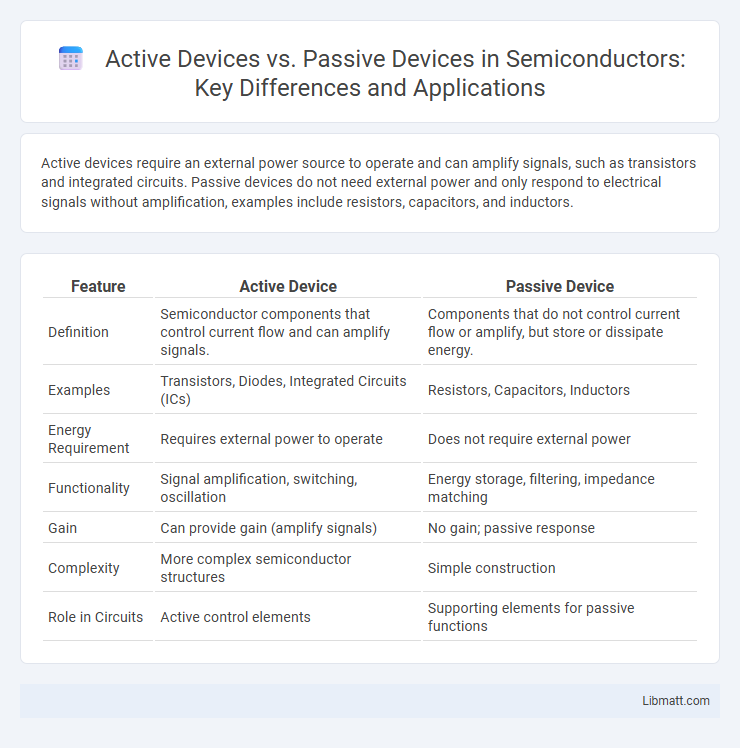Active devices require an external power source to operate and can amplify signals, such as transistors and integrated circuits. Passive devices do not need external power and only respond to electrical signals without amplification, examples include resistors, capacitors, and inductors.
Table of Comparison
| Feature | Active Device | Passive Device |
|---|---|---|
| Definition | Semiconductor components that control current flow and can amplify signals. | Components that do not control current flow or amplify, but store or dissipate energy. |
| Examples | Transistors, Diodes, Integrated Circuits (ICs) | Resistors, Capacitors, Inductors |
| Energy Requirement | Requires external power to operate | Does not require external power |
| Functionality | Signal amplification, switching, oscillation | Energy storage, filtering, impedance matching |
| Gain | Can provide gain (amplify signals) | No gain; passive response |
| Complexity | More complex semiconductor structures | Simple construction |
| Role in Circuits | Active control elements | Supporting elements for passive functions |
Introduction to Active and Passive Devices
Active devices are electronic components that require external power to operate and can amplify signals, such as transistors and integrated circuits. Passive devices, including resistors, capacitors, and inductors, do not need external power and cannot amplify signals but can store or dissipate energy. Understanding the distinction between active and passive devices is crucial for designing electronic circuits with specific functions and performance characteristics.
Definition of Active Devices
Active devices are electronic components that require an external power source to operate and can amplify or control electrical signals. Examples include transistors, integrated circuits, and diodes, which actively influence the flow of current within a circuit. These devices are essential in signal processing, amplification, and switching applications due to their ability to inject energy into the circuit.
Definition of Passive Devices
Passive devices are electronic components that do not require an external power source to operate and cannot amplify or generate electrical signals. Common examples include resistors, capacitors, inductors, and transformers, which primarily store or dissipate energy. These devices play a crucial role in circuits by controlling voltage, current, and signal flow without adding energy to the system.
Key Differences Between Active and Passive Devices
Active devices, such as transistors and integrated circuits, require an external power source to operate and can amplify signals or control current flow. Passive devices, including resistors, capacitors, and inductors, do not need external power and only respond to electrical signals without amplification. Understanding these key differences helps you select the right component for your electronic circuit design based on functionality and power requirements.
Functions and Applications of Active Devices
Active devices, such as transistors and integrated circuits, amplify signals and control electrical energy flow, requiring an external power source for operation. They play crucial roles in applications like signal processing, amplification, switching, and power regulation, enabling advancements in communication systems, computing, and consumer electronics. Your electronic designs benefit from active devices by enhancing performance, efficiency, and functionality in complex circuits.
Functions and Applications of Passive Devices
Passive devices, such as resistors, capacitors, and inductors, perform essential functions like energy storage, signal filtering, and impedance matching without requiring an external power source. These components are widely used in applications including power supplies, audio equipment, and communication systems to control current flow and voltage levels. Your electronic circuits benefit from passive devices' reliability and simplicity in managing electrical signals and power distribution.
Advantages of Active Devices
Active devices, such as transistors and integrated circuits, offer significant advantages by amplifying signals and controlling electrical current in electronic circuits, enabling complex functionalities in modern devices. These components provide better signal processing, higher efficiency, and the ability to introduce gain, which passive devices like resistors and capacitors cannot achieve. Your electronic circuits benefit from improved performance and greater control when incorporating active devices.
Advantages of Passive Devices
Passive devices offer significant advantages such as low power consumption, high reliability, and minimal maintenance requirements. These components, including resistors, capacitors, and inductors, do not require an external power source and generate less heat, making them ideal for stable and long-lasting circuit designs. Your electronic systems benefit from their simplicity and cost-effectiveness, ensuring efficient operation in various applications.
Limitations of Active and Passive Devices
Active devices require external power sources to operate, which can limit their use in low-power or remote applications, and they may introduce noise affecting signal quality. Passive devices do not need power but are constrained by their inability to amplify signals, restricting their functionality to signal attenuation or filtering. Understanding these limitations helps you choose the appropriate device for efficient circuit design and optimal performance.
Choosing Between Active and Passive Devices: Factors to Consider
Choosing between active and passive devices requires evaluating power requirements, signal amplification needs, and cost constraints. Active devices, such as transistors and integrated circuits, require external power to operate and offer signal gain, making them ideal for applications demanding amplification or switching. Passive devices like resistors, capacitors, and inductors do not need power and are best suited for simple circuit functions such as filtering, impedance matching, or energy storage.
Active Device vs Passive Device Infographic

 libmatt.com
libmatt.com